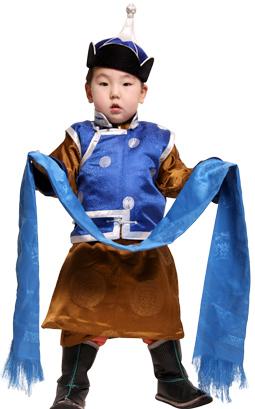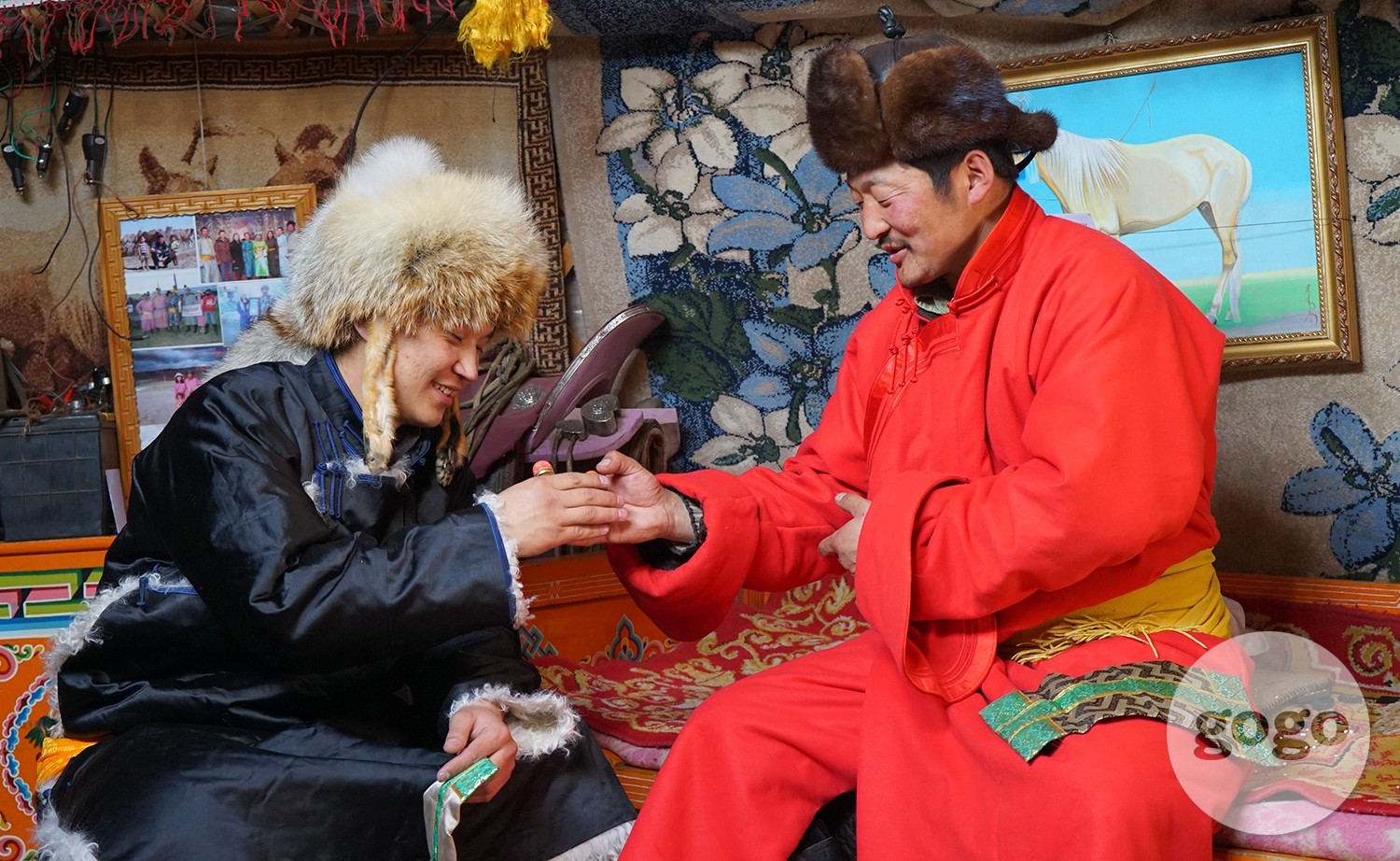FIRST DAY OF TSAGAAN SAR
In the first morning of Tsagaan Sar young and old alike get up early, take some food, tea, table or mat etc and go to "ovoo", cairn erected as a shrine or to an eminence, and have ceremony such as praying to the heavens and making a ritual start in a prescribed direction at New Year. From there, they go to give New Year greetings to their parents, brothers, sisters, relatives and neighbors in order of age. People greet each other in a unique way. The younger people vow to the elderly and cross their hands under the hands of the older people supporting their elbow, with an offer of "Hadag", a blue scarf as token of respect.
Greeting with Hadag
 Hadag differs by its length and symbols on it. If it has image of a human it is mostly given to parents, elders and honored guests. If the hadag has sun, moon and words, it is mostly used during funerals.
Hadag differs by its length and symbols on it. If it has image of a human it is mostly given to parents, elders and honored guests. If the hadag has sun, moon and words, it is mostly used during funerals.
Hadag should be given to elder with the open end of a fold directly to hands of other person and should be received with both hands and respectfully folded and put away. When greeting an elder or respected guest with hadag special greeting words that ask if the greeted person is in good health and if the New Year is being good.
But the hadag greeting also differs by how the greeting person holds the hadag. If the person has wrapped ring finger twice with hadag, it means he shows respect and greets everyone with hadag and this hadag stays with the person. Usually elders do so.
If the person is holding hadag without wrapping finger it means he intends to gift the hadag and one must receive it respectfully. If person you are to greet starts wrapping the ring finger with hadag it also should be understood as great respect towards you.
Greeting with snuff-bottles

Thereafter, the guests have a seat and exchange snuff-bottles in greeting and say: have you got through the winter in plenty and seeing at spring well. With these traditional New Year greetings they encourage each other.
Younger person starts the greeting with snuff-bottle by loosening the cap of the bottle by turning it to right three times and snuffing it first and offer it to elder person with right hand. In return elder person gets own snuff-bottle loosens the cap as well and exchange. Loosening the cap means that person has no bad thoughts and comes in peace. Receiving the snuff-bottle should be done with both hands, proceeded with sniffing the bottle and giving it back little bit tightening the cap, which means the person accepts coming in peace.
It is prohibited to loosen button on deel and roll up sleeve when greeting with snuff-bottle.

When the elderly offer a round of drinking and singing, long-songs "Bogd Chinggis Khaan", "Heavens Wind", Stupa Height" are performed in chorus and a couple of drinks can be consumed. Then the guests say "many visits ahead, long distances to go, horses get frosted", and mount their horses to continue their visits.
Another practice is people observe signs of the coming year from dawn till dark during the first day of Tsagaan Sar. For example, a slow break of day at dawn and crystal-clear cloudless sky at sunrise symbolizes a fortunate year for babies and little ones.
Things to avoid doing during Tsagaan Sar
1. To get water from springs or rivers. Water buckets should be filled beforehand
2. To sew old clothes. Only sewing of new garments are welcomed and seen as good wishing for New Year.
3. To borrow and lend.
4. To cry and quarrel. It is believed that whole year will be bad with disputes.
5. To throw away ash from stove. Cleaning should be done on Bituun.
6. To say bad words, to hunt, to kill animal.
7. To greet elders and relatives, to go to other household on seventh day of New Year, as this year is considered as black day.
8. To greet one’s husband or wife. Doing so might end in split and become enemies.
9. To overdrink and be disrespectful at the feast table.
10. To carry knife. This means that someone came with bad intentions.
Historically, Tsagaan Sar has been always the most honored celebration as it has to do with all, young and old alike.
FIRST DAY OF TSAGAAN SAR
In the first morning of Tsagaan Sar young and old alike get up early, take some food, tea, table or mat etc and go to "ovoo", cairn erected as a shrine or to an eminence, and have ceremony such as praying to the heavens and making a ritual start in a prescribed direction at New Year. From there, they go to give New Year greetings to their parents, brothers, sisters, relatives and neighbors in order of age. People greet each other in a unique way. The younger people vow to the elderly and cross their hands under the hands of the older people supporting their elbow, with an offer of "Hadag", a blue scarf as token of respect.
Greeting with Hadag
 Hadag differs by its length and symbols on it. If it has image of a human it is mostly given to parents, elders and honored guests. If the hadag has sun, moon and words, it is mostly used during funerals.
Hadag differs by its length and symbols on it. If it has image of a human it is mostly given to parents, elders and honored guests. If the hadag has sun, moon and words, it is mostly used during funerals.
Hadag should be given to elder with the open end of a fold directly to hands of other person and should be received with both hands and respectfully folded and put away. When greeting an elder or respected guest with hadag special greeting words that ask if the greeted person is in good health and if the New Year is being good.
But the hadag greeting also differs by how the greeting person holds the hadag. If the person has wrapped ring finger twice with hadag, it means he shows respect and greets everyone with hadag and this hadag stays with the person. Usually elders do so.
If the person is holding hadag without wrapping finger it means he intends to gift the hadag and one must receive it respectfully. If person you are to greet starts wrapping the ring finger with hadag it also should be understood as great respect towards you.
Greeting with snuff-bottles

Thereafter, the guests have a seat and exchange snuff-bottles in greeting and say: have you got through the winter in plenty and seeing at spring well. With these traditional New Year greetings they encourage each other.
Younger person starts the greeting with snuff-bottle by loosening the cap of the bottle by turning it to right three times and snuffing it first and offer it to elder person with right hand. In return elder person gets own snuff-bottle loosens the cap as well and exchange. Loosening the cap means that person has no bad thoughts and comes in peace. Receiving the snuff-bottle should be done with both hands, proceeded with sniffing the bottle and giving it back little bit tightening the cap, which means the person accepts coming in peace.
It is prohibited to loosen button on deel and roll up sleeve when greeting with snuff-bottle.

When the elderly offer a round of drinking and singing, long-songs "Bogd Chinggis Khaan", "Heavens Wind", Stupa Height" are performed in chorus and a couple of drinks can be consumed. Then the guests say "many visits ahead, long distances to go, horses get frosted", and mount their horses to continue their visits.
Another practice is people observe signs of the coming year from dawn till dark during the first day of Tsagaan Sar. For example, a slow break of day at dawn and crystal-clear cloudless sky at sunrise symbolizes a fortunate year for babies and little ones.
Things to avoid doing during Tsagaan Sar
1. To get water from springs or rivers. Water buckets should be filled beforehand
2. To sew old clothes. Only sewing of new garments are welcomed and seen as good wishing for New Year.
3. To borrow and lend.
4. To cry and quarrel. It is believed that whole year will be bad with disputes.
5. To throw away ash from stove. Cleaning should be done on Bituun.
6. To say bad words, to hunt, to kill animal.
7. To greet elders and relatives, to go to other household on seventh day of New Year, as this year is considered as black day.
8. To greet one’s husband or wife. Doing so might end in split and become enemies.
9. To overdrink and be disrespectful at the feast table.
10. To carry knife. This means that someone came with bad intentions.
Historically, Tsagaan Sar has been always the most honored celebration as it has to do with all, young and old alike.

